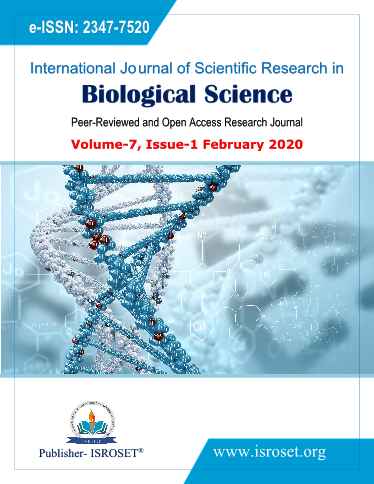Garcinia cowa: A Potential target for Drug Therapy against Lung Cancer
Keywords:
Garcinia cowa, MTT, assay, Lung cancer cell line (A549)Abstract
Plants, besides providing raw materials for our sustenance, also having therapeutic properties to cure many chronic diseases like cancer, diabetics and cardiac problems. As they are easily available, cheaper and have no toxicity when compared to chemical drugs, the demands of their products commence increasing for treatments. Moreover, the estimated rate of cancer patients has begun to raise gradually, the necessity to find an active compound from plants becomes more important. So the phytoconstituents present in the medicinal plants have been isolated and marketed as anticancer drugs depend on their traditional values and scientific reports. In our present study, the Garcinia cowa, a traditional medicinal plant was screened. The extraction process has been done by maceration for all parts of the plant with suitable solvents. Crude extracts were then subjected to phytochemical analysis. The selected extract was examined by trypan blue dye exclusion technique to determine the cell viability. The active extract has shown dose-dependent cytotoxicity against lung cancer (CTC50 - 2.29) whereas it has shown less cytotoxicity towards normal Vero cells (CTC50 - 0.10).
References
Robert L. Keith, “Lung Carcinoma”, MSD Manual Professional Version, 2018.
Vinay Kumar, Abul Abbas and Jon Aster, “Robbins Basic Pathology”, Edi. 9, pp. 928, 2012.
Leora Horn, Christine M. Lovely and David H. Johnson, “Neoplasms of the Lung”, Harrison`s Principles of Internal Medicine, Edi. 19, 2012.
S. McGuire, “World Cancer Report 2014. Geneva, Switzerland: World Health Organization, International Agency for Research on Cancer, WHO Press, 2015”, Vol. 7, Issue. 2, pp. 418-419, 2016.
M.J. Thun, L.M. Hannan and L.L. AdamsCambell, “Lung cancer occurrence in never smokers: an analysis of 13 cohorts and 22 cancer registry studies”, PLOSMedicine, Vol. 5, Issue. 9, pp. 1185, 2008.
K.M. 0’Reilly, A.M. Mclaughlin and W.S.Beckett, “Asbestos-related lung disease”, American Family Physician, Vol. 75, Issue. 5, pp.683-688, 2007.
B.A. Chabner and T.G. Roberts Jr, “Chemotherapy and the War on Cancer”, Nature Reviews Cancer, Vol.5, pp.65-72, 2005.
Y. Chen, P. Jungsuwadee, M. Vore, D.A. Butterfield and D.K. St Clair, “Collateral Damage in Cancer Chemotherapy: Oxidative Stress in Nontargeted Tissues”, Molecular Interventions, Vol.7, 147-156, 2007.
A. Kijjoa and L.M.M. Vieira, “Triterpenes from the plants of the Family Clusiaceae (Guttiferae): Chemistry and biological activities. Natural Products: Chemistry, Biochemistry and Pharmacology”, Alpha Science International Ltd, Oxford, Vol. 13, 2009.
W.H. Ansari, W. Rahman, D. Barraclough, R. Maynard and F. Scheinman, “Biflavanoids and a flavanone-chromone from the leaves of Garcinia dulcis (Roxb.) Kurz”, Journal of the Chemical Society, Perkin Transactions, vol. 1, Issue. 13, pp. 1458-1463, 1976.
V. Rukachaisirikul, T. Ritthiwigrom, A. Pinsa, P. Sawangchote and W.C. Taylor, “ Xanthones from the stem bark of Garcinia nigrolineata”, Phytochemistry, Vol. 6, pp. 1149-1156, 2003.
G. Xu, W.L.T. Kan, Y. Zhou, J.Z. Song, Q.B. Han, C.F. Qiao, C.H. Cho, J.A. Rudd, G. Lin and H.X. Xu, “ Cytotoxic acylphloroglucinol derivatives from the twigs of Garcinia cowa”, Journal of Natural Products, Vol. 73, pp. 104-108, 2010.
H.W. Ryu, M.J. Curtis-Long, S. Jung, Y.M. Jin, J.K Cho, Y.B. Ryu, W.S. Lee and K.H. Park, “Xanthones with neuraminidase inhibitory activity from the seedcases of Garcinia mangostana.Bioorg”, Journal of Medicinal Chemistry, Vol. 18, pp. 6258-6264, 2010.
Ammar Adnan Tuama , Arif Ahmed Mohammed, “Phytochemical screening and in vitro antibacterial and anticancer activities of the aqueous extract of Cucumis sativus”, Saudi Journal of Biological Sciences, Vol. 26, pp. 600–604, 2019.
P.S. Negi, G.K. Jayaprakasha and B.S. Jena, “Evaluation of Antioxidant and Antimutagenic Activities of the Extracts from the Fruit Rinds of Garcinia cowa”, International Journal of Food Properties, Vol.13, Issue. 6, pp. 1256-1265, 2010.
K. Vijayalakshmi, N. Priya, A. Khadira Sereen, and R. Ranjani, “ Preliminary Phytochemical Screening of the fruit rind of Garcinia cambogia and leaves of Bauhinia variegate- A Comparative study”, International Journal of Current Microbiology and Applied Sciences, Vol. 3, Issue. 5, pp. 479-486, 2014.
V. Anju and K.B. Rameshkumar, “Phytochemicals and bioactivities of Garcinia gummi- gutta (L.) N. Robson- A review”, Diversity of Garcinia species in the Western Ghats: Phytochemical Perspective, chapter 10, 2017.
Carlo Avila Limbo and Sonia Donaldo Jacinto, “Cytotoxic Potential and Phytochemical Profile of Extracts from Garcinia rubra Merr. Leaves”, International Journal of Cancer Research, Vol. 15, pp. 38-46, 2019.
Downloads
Published
How to Cite
Issue
Section
License

This work is licensed under a Creative Commons Attribution 4.0 International License.
Authors contributing to this journal agree to publish their articles under the Creative Commons Attribution 4.0 International License, allowing third parties to share their work (copy, distribute, transmit) and to adapt it, under the condition that the authors are given credit and that in the event of reuse or distribution, the terms of this license are made clear.







